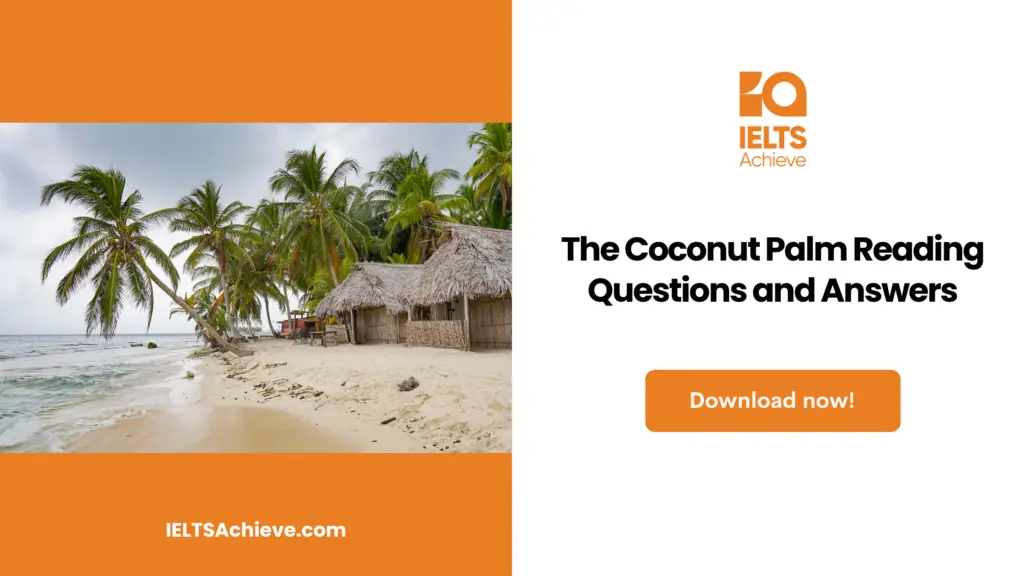The Blog post contains the following IELTS Reading Questions:
- IELTS Reading Locating Information
- IELTS Reading Summary Completion
- IELTS Reading Short Answer Question
Stay informed and prepared for success – Explore our comprehensive Reading Test Info page to get valuable insights, exam format details, and expert tips for mastering the IELTS Reading section.
IELTS reading passage – The Coconut Palm

The Coconut Palm
For thousands of years, the coconut has been integral to the lives of Polynesian and Asian peoples. On the other hand In the west, coconuts have always been exotic and unusual, sometimes rare. In the late 13th century the Italian merchant traveller Marco Polo apparently saw coconuts in South Asia. During the mid-14th-century, in the travel writings of Sir John Mandeville, there is mention of ‘great Notes of India’ (great Nuts of India). Images of tropical beaches with palm trees are clichés in the west today, to sell holidays, chocolate bars, fizzy drinks, and even romance.
We conceive coconuts as brown cannonballs that, when opened, provide sweet white flesh. But we see none of the plants from which they come and only part of the fruit. The coconut palm has a slender, smooth, grey trunk that grows up to 30 metres tall. The trunk is an important source of timber for constructing houses and is mostly used to replace endangered trees from the furniture construction industry. The trunk, each of which may be up to 6 metres long, is surmounted by a rosette of leaves. They have hard veins in their centres which are used as brushes in many parts of the world after the green part of the leaf has been stripped away. At the top of the trunk immature coconut flowers are tightly clustered together among the leaves. The stems of the flowers are tapped to produce a drink from their sap, and it can also be reduced by boiling to make a type of sugar that can be used for cooking.
Coconut palms produce as many as 70 fruits per year, almost a kilogram each. The wall of the fruit has 3 layers – an outer waterproof layer, a fibrous middle layer, and an inner hard layer. The middle layer produces coconut fibre, ‘coir’, which has many uses and is particularly important in making ropes. The woody shell, which is the innermost layer with its 3 prominent ‘eyes’, surrounds the seed. Charcoal is an important product obtained from the shell, which is used in many industries and also as cooking fuel in the houses. The shells are broken in half and are used as bowls in many parts of Asia.
There are nutrients (endosperm) inside the shell that are needed by the developing seed. The endosperm is a sweetish liquid, coconut water, that provides the hormones which encourage other plants to grow more rapidly and produce higher yields and is also enjoyed as a drink. The coconut water gradually solidifies to form the brilliant white, fat-rich, edible flesh or meat as the fruit matures. Dried coconut flesh, ‘copra’, is made into coconut milk and coconut oil, which are widely used in cooking in different parts of the world. It is also used in cosmetics. As Alfred Nobel introduced the world to his nitroglycerine-based invention: dynamite, Glycerine, a derivative of coconut fat, gained strategic importance in a quite different sphere.
Their structure makes coconuts a great maritime voyager and coastal colonisers of the plant world. These large and energy-rich fruits are able to float in water and tolerate salt, but cannot remain feasible indefinitely. After about 110 days at sea studies say that they are no longer able to germinate. With little more than sand to grow on desert island shores, coconut seeds are able to germinate being exposed to the tropical sun. The embryo is protected by the air pocket inside the seed that is created when the endosperm solidifies. The fibrous fruit wall that helped it to float during the voyage stores moisture and as it starts to grow it can be taken up by the roots of the coconut seedling.
Regarding the origins of the coconut there have been centuries of academic debate. Before the voyages of the European explorers Vasco da Gama and Columbus there were no coconut palms in West Africa, the Caribbean or the east coast of the Americans in the late 15th and early 16th centuries. 16th-century trade and human migration patterns reveal that Arab traders and European sailors might be the people who have been the reason why coconuts were found in Africa and then to the east coast of America across the Atlantic. Discussions went on for centuries about the origin of coconuts discovered along the west coast of America by 16th-century sailors. 2 diametrically opposed origins have been proposed. One that they came from Asia, and second that they were native to America. Both have problems. There is a large degree of coconut diversity in Asia and evidence of human use for thousands of years. There are close coconut relatives in America, but no evidence that coconuts are native. These have led to the intriguing suggestion that coconuts originated on coral islands in the Pacific and were dispersed from there.
Unlock your full potential in the IELTS Reading section – Visit our IELTS Reading Practice Question Answer page now!
Recommended Questions:
Renewable Energy IELTS Reading Question with Answer
The Coconut Palm IELTS reading questions
Questions 1-5
This reading passage has six paragraphs, A–F. Which paragraph contains the following information? Write the correct letter, A – F, as your answer to each question.
1. The coconut was an important part of the lives of Polynesian and Asian peoples.
2. Coconut palms produce as many as 70 fruits per year.
3. Coconuts cannot germinate after 110 days at sea.
4. The coconut palm can grow up to 30 metres in length.
5. Coconuts are not native to America.
Questions 6-9
Complete the summary below.
Write NO MORE THAN TWO WORDS from the passage for each answer.
The history of coconuts dates back to thousands of years. In the late 6________ the Italian merchant traveller Marco Polo apparently saw coconuts in South Asia. Coconuts are brown cannonballs that, when opened, provide sweet 7________. The wall of the fruit has 3 layers – an outer 8________, a fibrous middle layer, and an inner hard layer. Before the voyages of the European explorers Vasco da Gama and 9________ there were no coconut palms in West Africa, the Caribbean or the east coast of the Americans in the late 15th and early 16th centuries. There have been centuries of academic debate about the origins of the coconut.
Boost your performance in Summary, Notes, Table, and Flowchart Completion tasks. Click here to explore our detailed guide and learn how to effectively complete summaries, notes, tables, and flowcharts in the IELTS Reading section.
Questions 10-14
Answer the questions below.
Choose NO MORE THAN THREE WORDS from the passage for each answer.
10. Who mentioned ‘great Notes of India’ in his book?
11. How long will the trunk grow?
12. What is the charcoal obtained from the shell used as?
13. Where does the developing seed get its nutrients from?
14. Which part of the world uses coconut shells as bowls?
Unlock your full potential in the IELTS Reading section – Visit our IELTS Reading Practice Question Answer page now!
Recommended Questions:
Renewable Energy IELTS Reading Question with Answer
The Coconut Palm IELTS reading answers
1. Paragraph A
2. Paragraph C
3. Paragraph E
4. Paragraph B
5. Paragraph F
6. 13th century
7. white flesh
8. waterproof layer
9. Columbus
10. Sir John Mandeville
11. 6 metres
12. cooking fuel
13. Endosperm
14. Asia

We hope you found this post useful in helping you to study for the IELTS Test. If you have any questions please let us know in the comments below or on the Facebook page.
The best way to keep up to date with posts like this is to like us on Facebook, then follow us on Instagram and Pinterest. If you need help preparing for the IELTS Test, join the IELTS Achieve Academy and see how we can assist you to achieve your desired band score. We offer an essay correction service, mock exams and online courses.

